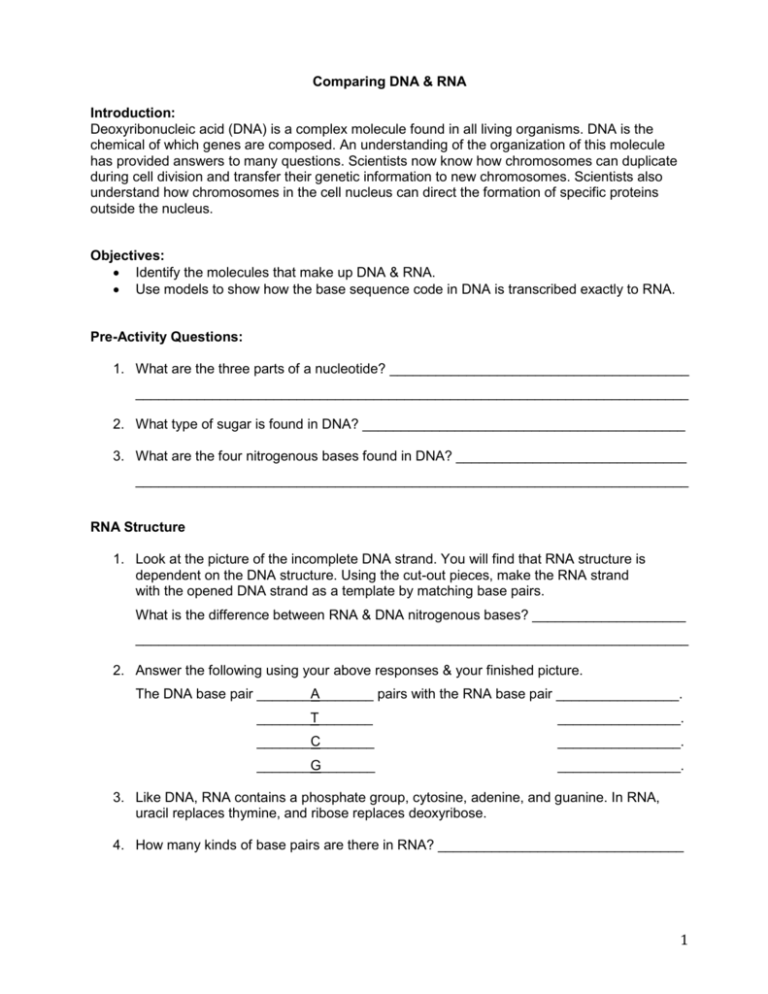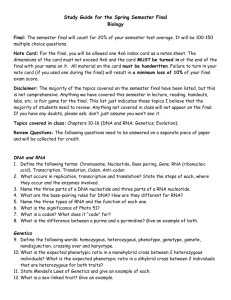packet
advertisement

Comparing DNA & RNA Introduction: Deoxyribonucleic acid (DNA) is a complex molecule found in all living organisms. DNA is the chemical of which genes are composed. An understanding of the organization of this molecule has provided answers to many questions. Scientists now know how chromosomes can duplicate during cell division and transfer their genetic information to new chromosomes. Scientists also understand how chromosomes in the cell nucleus can direct the formation of specific proteins outside the nucleus. Objectives: Identify the molecules that make up DNA & RNA. Use models to show how the base sequence code in DNA is transcribed exactly to RNA. Pre-Activity Questions: 1. What are the three parts of a nucleotide? _______________________________________ ________________________________________________________________________ 2. What type of sugar is found in DNA? __________________________________________ 3. What are the four nitrogenous bases found in DNA? ______________________________ ________________________________________________________________________ RNA Structure 1. Look at the picture of the incomplete DNA strand. You will find that RNA structure is dependent on the DNA structure. Using the cut-out pieces, make the RNA strand with the opened DNA strand as a template by matching base pairs. What is the difference between RNA & DNA nitrogenous bases? ____________________ ________________________________________________________________________ 2. Answer the following using your above responses & your finished picture. The DNA base pair _______A_______ pairs with the RNA base pair ________________. _______T_______ ________________. _______C_______ ________________. _______G_______ ________________. 3. Like DNA, RNA contains a phosphate group, cytosine, adenine, and guanine. In RNA, uracil replaces thymine, and ribose replaces deoxyribose. 4. How many kinds of base pairs are there in RNA? ________________________________ 1 5. Look at the top of page 3. Which molecules are found in all RNA nucleotides? _________ ________________________________________________________________________ 6. What are the four different bases in RNA? ______________________________________ ________________________________________________________________________ RNA Transcription RNA is a single stranded (or ½ ladder) molecule. Thus, the series of RNA nucleotides formed from DNA represents an RNA molecule. After its formation, this RNA leaves the nucleus of the cell and goes to the ribosomes. It carries the DNA message of base sequences in the exact same order. Therefore, the formation of this series of RNA nucleotides is called transcription. 1. List the nucleotides on the DNA side of the laminated picture, from top to bottom. ________________________________________________________________________ ________________________________________________________________________ 2. Examine the completed RNA strand of your picture – it should look like the other side of the ladder. List the nucleotides on the RNA side of the picture from top to bottom. ________________________________________________________________________ ________________________________________________________________________ Data & Observations Complete the table by using check marks to indicate to which molecule each characteristic applies. Use the picture on the bottom of page 3& your laminated picture to help you. DNA RNA Ribose present Deoxyribose present Phosphate present Adenine present Thymine present Uracil present Guanine present Cytosine present Double stranded Single stranded 2 DNA Nucleotide RNA Nucleotide Comparing DNA & RNA 3 Analysis Questions 1. Only two possible base-pair combinations can be formed in DNA. Name these pairs. ________________________________________________________________________ 2. How do DNA & RNA molecules compare? ______________________________________ ________________________________________________________________________ 3. How do DNA & RNA molecules differ? _________________________________________ ________________________________________________________________________ 4. The following are the bases on the left side of a DNA molecule. List the bases that would make up the right side of a DNA molecule. a. Thymine ____________________________________________________________ b. Adenine ____________________________________________________________ c. Guanine ____________________________________________________________ d. Guanine ____________________________________________________________ e. Cytosine ____________________________________________________________ f. Adenine ____________________________________________________________ 5. The following are the bases on one side of a DNA molecule. List the bases that would make up a molecule of RNA paired to these bases. a. Guanine ____________________________________________________________ b. Adenine ____________________________________________________________ c. Adenine ____________________________________________________________ d. Thymine ____________________________________________________________ e. Cytosine ____________________________________________________________ f. Guanine ____________________________________________________________ 6. How are DNA replication and RNA transcription alike? ____________________________ ________________________________________________________________________ ________________________________________________________________________ 7. How are DNA replication and RNA transcription different? _________________________ ________________________________________________________________________ ________________________________________________________________________ 4







